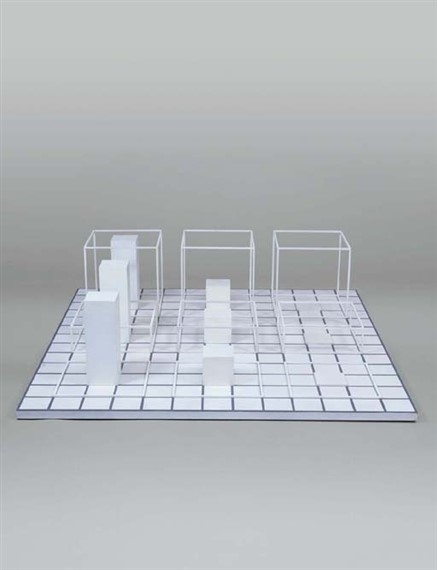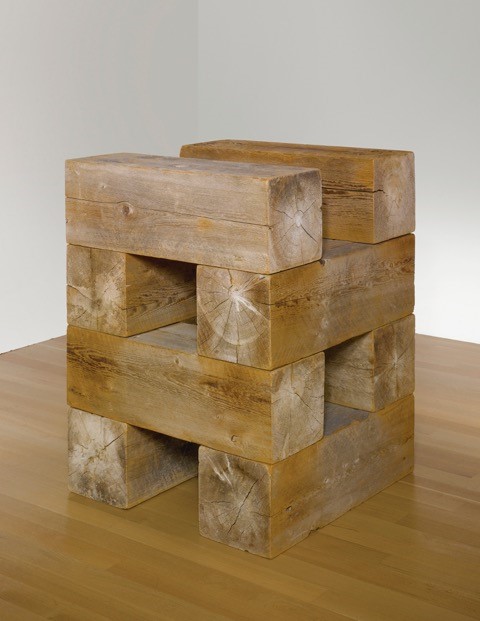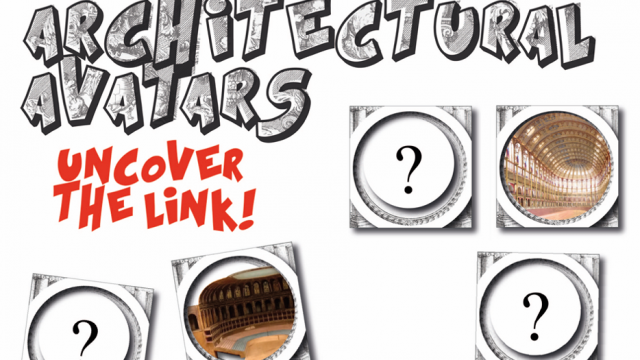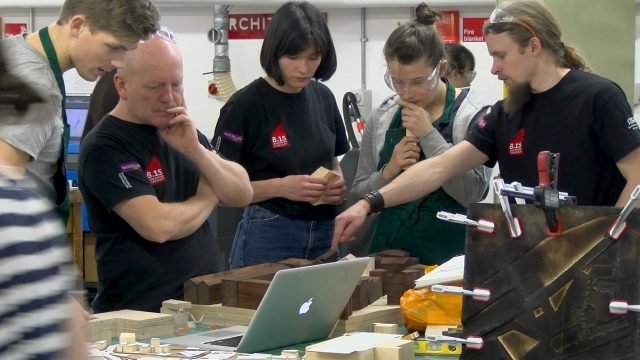
In March 1985, the advertisement pages of the art journal Kunstforum International featured an enigmatic image. The photograph depicts a group of architectural objects, more specifically scale models, which are carefully staged in a gallery interior. In the front and back left, we recognize miniature versions of buildings and projects by the Italian architect Aldo Rossi. Teatro del Mondo (1979), a cuboid theatre space flanked by two rectangular staircases and topped by an octagonal tower, and an unrealized project for a congressional palace in Milan (1982), are represented by a realistic model and a wooden object evoking a section, respectively. Such objects, despite their intricate materiality, are familiar enough. Made by or ascribed to an architect, these scale models are viewed and understood as surrogates, secondary versions of the projects or buildings they represent. Models like these substitute for architecture, which—as a cliché of architecture exhibitions goes—cannot be easily displayed in the museum or gallery.

The remaining objects, however, are more ambiguous. These scale models, realized by artists, do not anticipate a future work or substitute for a building per se; and neither were they made for a specific site or commissioner. More than architectural surrogates, they are works of art proper that examine the assorted meanings of typically architectural objects in the visual arts. Ludger Gerdes’s Landhäuser (Country Houses) (1984), shown in the middle of the image, is a duo of pitch-roof houses made on a nondescript scale and painted for the most part white. One house stands on pilotis and has solid walls on its first floor, while the other structure reverses this floor order; it has a solid ground floor and a colonnade on top. These syntagmatic houses clearly are informed by architecture: they reference Le Corbusier’s prototype of a serially buildable housing unit, the Maison Dom-Ino (1914–15), as well as Léon Krier’s neoclassicism. But Gerdes’s work also dialogues with precursors in art: for example, with Donald Judd’s vertical stackings, Carl Andre’s works made of industrial units, or the sculptural permutations of Sol LeWitt. At the back, Thomas Schütte’s Modelle (Models) (c. 1983–84) represent studios on a scale of 1:100. One model, painted red, shows two stackings of individual rooms and a saw-tooth-roof atelier on top, while the other, in white, evokes a house of a single stacking of rooms and a ground-floor, barrel-roof atelier. Made of elements that evoke the program of the building (a top-light atelier for a painter, a side-lit one for a sculptor), these works refer to late-eighteenth-century architecture parlante, most notably to Claude Nicolas Ledoux. But the Modelle also resonate with artists’ reflections on the studio, for example, with the writings of Daniel Buren and videos of Bruce Nauman. These works, in other words, can be read in relation to both art and architecture.

Models by Gerdes and Schütte are complex, hybrid objects that reflect upon themes, examples, and precursors in two disciplinary domains at once. They suggest how, at the onset of the 1980s, the expansion of sculpture into a contemporary, ‘post-medium’ type of practice intersected with themes and concerns central to postmodern architecture. Of course, the 1985 image does not literally visualize this claim. Commissioned by art and architecture critic, gallerist, curator, and trained architect Jörg Johnen, and made by the artist Thomas Ruff, this photograph served to promote the Galerie für Architektur und Kunst Johnen & Schöttle, established in Cologne by Johnen and gallerist Rüdiger Schöttle in autumn 1984. Johnen & Schöttle aimed to present works by artists and architects, convinced as Johnen was of a mutual interest of practitioners in each other’s domains. As the first press release states, the gallery set out to present works by “artists and architects, whereby [it] aims to be a place that stimulates collaboration between the different arts, through exemplary exhibitions.”[1] Unfortunately, this ambition went unfulfilled: nearly all shows at Johnen & Schöttle’s focused on art, which led to the abandonment of the interdisciplinary focus and the subsequent renaming of the gallery already in April 1988.[2] If artists displayed a genuine interest in the work of architects, the allure, so Johnen related later, was not mutual. Nevertheless, the image is a rich document. Staging, in Johnen’s words, “an interplay of art and architecture, a phantasy about the city,” the photograph latently posits that artists explored not just objects, but also discussions and practices of architecture. Indeed, many, if also subtle, echoes suggest this fascination: the flag on top of Rossi’s Theatro and in front of Schütte’s studio for a painter; the blue lines demarcating the facade of the theater and Gerdes’s villas; the austere, stern forms used by the architect and the composed, even cold designs of the artists; or the symmetry and repetition of elements in all of the models. Scale models by Gerdes and Schütte (and indirectly by Dan Graham as well) resonate with themes and questions in art, and with architecture theory and history alike.

[1] “Pressemitteilung Galerie für Architektur Johnen & Schöttle,” 29 September 1984, archive Jörg Johnen, unpaginated.
[2] Johnen Galerie (http://www.johnengalerie.de accessed 11 September 2018).
To find out more about the network visit our project page.


